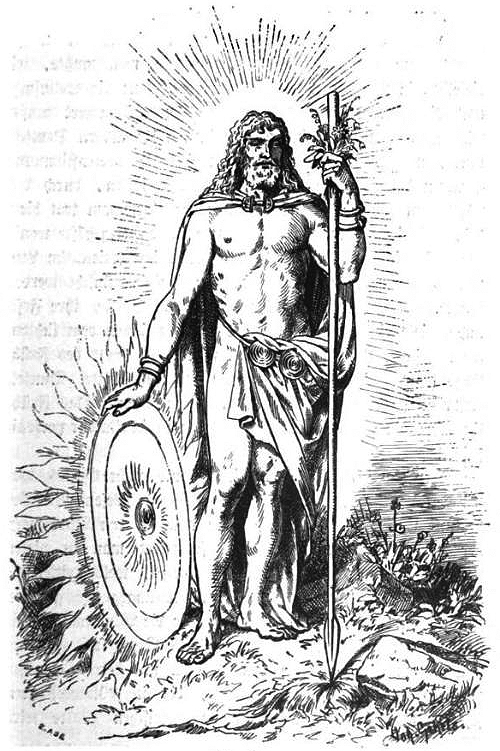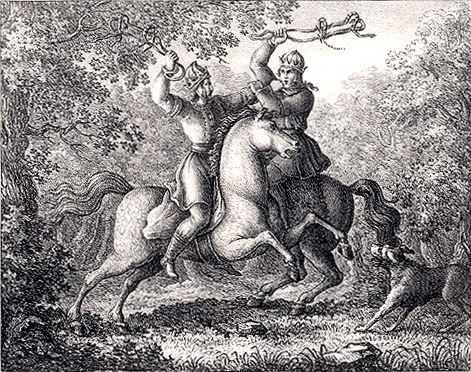|
Gestumblindi
Gestumblindi is a character in Norse mythology who appears in '' Hervarar saga'' and in Saxo Grammaticus' ''Gesta Danorum'' as Gestiblindus. Later, he also appears in several Scandinavian folk tales as Gest Blinde. Hervarar saga According to Hervarar saga, Gestumblindi was a powerful man in Reidgotaland, i.e. a Goth, who had angered king Heidrek by refusing to pay him tribute. King Heidrek had in his hird twelve men who were entrusted to take care of all the legal disputes in the kingdom. If anyone had any complaint, they had the right to approach these men and would have right to both life and limb on the condition that they asked the king a number of riddles that the king could not answer. Heidrek sent a message to Gestumblindi that if he did not appear at the court at a certain date, he would be imprisoned. In desperation, Gestumblindi sacrificed to Odin asking him for assistance. Shortly thereafter, a stranger appeared at Gestumblindi's homestead, and this stranger also ca ... [...More Info...] [...Related Items...] OR: [Wikipedia] [Google] [Baidu] |
Odin
Odin (; from non, Óðinn, ) is a widely revered Æsir, god in Germanic paganism. Norse mythology, the source of most surviving information about him, associates him with wisdom, healing, death, royalty, the gallows, knowledge, war, battle, victory, sorcery, poetry, frenzy, and the Runes, runic alphabet, and depicts him as the husband of the goddess Frigg. In wider Germanic mythology and paganism, the god was also known in Old English as ', in Old Saxon as , in Old Dutch as ''Wuodan'', in Old Frisian as ''Wêda'', and in Old High German as , all ultimately stemming from the Proto-Germanic language, Proto-Germanic theonym *''Wōðanaz'', meaning 'lord of frenzy', or 'leader of the possessed'. Odin appears as a prominent god throughout the recorded history of Northern Europe, from the Roman occupation of regions of Germania (from BCE) through movement of peoples during the Migration Period (4th to 6th centuries CE) and the Viking Age (8th to 11th centuries CE). In the modern pe ... [...More Info...] [...Related Items...] OR: [Wikipedia] [Google] [Baidu] |
Balder
Baldr (also Balder, Baldur) is a god in Germanic mythology. In Norse mythology, Baldr (Old Norse: ) is a son of the god Odin and the goddess Frigg, and has numerous brothers, such as Thor and Váli. In wider Germanic mythology, the god was known in Old English as , and in Old High German as , all ultimately stemming from the Proto-Germanic theonym ('hero' or 'prince'). During the 12th century, Danish accounts by Saxo Grammaticus and other Danish Latin chroniclers recorded a euhemerized account of his story. Compiled in Iceland during the 13th century, but based on older Old Norse poetry, the ''Poetic Edda'' and the ''Prose Edda'' contain numerous references to the death of Baldr as both a great tragedy to the Æsir and a harbinger of Ragnarök. According to ''Gylfaginning'', a book of Snorri Sturluson's Prose Edda, Baldr's wife is Nanna and their son is Forseti. Baldr had the greatest ship ever built, Hringhorni, and there is no place more beautiful than his hall, Breidablik. ... [...More Info...] [...Related Items...] OR: [Wikipedia] [Google] [Baidu] |
Alrik
Alaric and Eric (Old Norse: ''Alrekr'' and ''Eiríkr''), according to legend, were two kings of Sweden. In the ''Ynglinga saga'' According to the ''Ynglinga saga'', Alaric and Eric were sons and heirs of the previous king Agni. They shared the kingship. They were mighty both in war and sport, but were especially skillful horsemen and vied with one another about their horsemanship and their horses. One day they rode off from their retinue and did not return. They were found dead with their heads battered but no weapons with them save the bridle bits of their horses. Accordingly it was believed that they had quarreled and come to blows and had slain each other with their bridle bits. They were succeeded by Alaric's sons Yngvi and Alf. However, in other sources, only Alaric died, and in the piece of Ynglingatal quoted by Snorri Sturluson it is only Alaric who dies explicitly. Eric's death seems to be a misunderstanding on Snorri's part due to an influence from the succeeding kin ... [...More Info...] [...Related Items...] OR: [Wikipedia] [Google] [Baidu] |
Norse Mythology
Norse, Nordic, or Scandinavian mythology is the body of myths belonging to the North Germanic peoples, stemming from Old Norse religion and continuing after the Christianization of Scandinavia, and into the Nordic folklore of the modern period. The northernmost extension of Germanic mythology and stemming from Proto-Germanic folklore, Norse mythology consists of tales of various deities, beings, and heroes derived from numerous sources from both before and after the pagan period, including medieval manuscripts, archaeological representations, and folk tradition. The source texts mention numerous gods such as the thunder-god Thor, the raven-flanked god Odin, the goddess Freyja, and numerous other deities. Most of the surviving mythology centers on the plights of the gods and their interaction with several other beings, such as humanity and the jötnar, beings who may be friends, lovers, foes, or family members of the gods. The cosmos in Norse mythology consists of Nine Worl ... [...More Info...] [...Related Items...] OR: [Wikipedia] [Google] [Baidu] |
Legendary Norsemen
Legendary may refer to: * Legend, a folklore genre * Legendary (hagiography) ** Anjou Legendarium * J. R. R. Tolkien's legendarium Film and television * ''Legendary'' (film), a 2010 American sports drama film * ''Legendary'', a 2013 film featuring Dolph Lundgren * ''Legendary'' (TV series), a 2020 American reality competition series * "Legendary" (''Legends of Tomorrow''), a television episode Music Albums * ''Legendary'' (AZ album), 2009 * ''Legendary'' (The Summer Set album) or the title song, 2013 * ''Legendary'' (TQ album) or the title song, 2013 * ''Legendary'' (Tyga album) or the title song, 2019 * ''Legendary'' (Z-Ro album), 2016 * ''Legendary'' (Zao album), 2003 * ''Legendary'', by Kaysha, 2006 * ''The Legendary'', an EP by the Roots, 1999 Songs * "Legendary" (Deadmau5 and Shotty Horroh song), 2017 * "Legendary" (Welshly Arms song), 2016 * "Legendary", by Alaska Thunderfuck from ''Anus'', 2015 * "Legendary", by Daya from '' Daya'', 2015 * "Legendary", by R ... [...More Info...] [...Related Items...] OR: [Wikipedia] [Google] [Baidu] |
Tyrfing Cycle
Tyrfing, Tirfing or Tyrving (the name is of uncertain origin, possibly connected to the Terwingi) was a magic sword in Norse mythology, which features in the Tyrfing Cycle, which includes a poem from the ''Poetic Edda'' called ''Hervararkviða'', and the Hervarar saga. The name is also used in the saga to denote the Goths. The form ''Tervingi'' was actually recorded by Roman sources in the 4th century. Svafrlami was the king of Gardariki, and Odin's grandson. He managed to trap the dwarfs Dvalinn and Durinn when they had left the rock where they dwelt. Then he forced them to forge a sword with a golden hilt that would never miss a stroke, would never rust and would cut through stone and iron as easily as through clothes. The dwarfs made the sword, and it shone and gleamed like fire. However, in revenge they cursed it so that it would kill a man every time it was drawn and that it would be the cause of three great evils. They finally cursed it so that it would also kill S ... [...More Info...] [...Related Items...] OR: [Wikipedia] [Google] [Baidu] |
Denmark
) , song = ( en, "King Christian stood by the lofty mast") , song_type = National and royal anthem , image_map = EU-Denmark.svg , map_caption = , subdivision_type = Sovereign state , subdivision_name = Danish Realm, Kingdom of Denmark , established_title = History of Denmark#Middle ages, Consolidation , established_date = 8th century , established_title2 = Christianization , established_date2 = 965 , established_title3 = , established_date3 = 5 June 1849 , established_title4 = Faroese home rule , established_date4 = 24 March 1948 , established_title5 = European Economic Community, EEC 1973 enlargement of the European Communities, accession , established_date5 = 1 January 1973 , established_title6 = Greenlandic home rule , established_date6 = 1 May 1979 , official_languages = Danish language, Danish , languages_type = Regional languages , languages_sub = yes , languages = German language, GermanGerman is recognised as a protected minority language in t ... [...More Info...] [...Related Items...] OR: [Wikipedia] [Google] [Baidu] |
King Of The Geats
Geatish kings ( la, Rex Getarum/Gothorum; sv, Götakungar), ruling over the provinces of Götaland (Gautland/Geatland), appear in several sources for early Swedish history. Today, most of them are not considered historical. This list follows the generally accepted identification between the names Götar (modern Swedish), Gautar (Old Norse) and Geatas (Old English), which is based both on tradition, literary sources and on etymology. However, unlike some translations it does not identify this tribe with the Goths. Both Old Norse and Old English records clearly separate the Geats from the Goths, while still depicting them as closely related to each other. From the Middle Ages until 1974, the king of Sweden claimed the title King of the Geats as "King of Sweden and Geats/Goths" or "Rex Sweorum et Gothorum". Danish monarchs used the similar title " King of the Goths" from 1362 until 1972. Legendary kings Some names appear in Norse mythology and in Germanic legend and in at lea ... [...More Info...] [...Related Items...] OR: [Wikipedia] [Google] [Baidu] |
Hawk
Hawks are bird of prey, birds of prey of the family Accipitridae. They are widely distributed and are found on all continents except Antarctica. * The subfamily Accipitrinae includes goshawks, sparrowhawks, sharp-shinned hawks and others. This subfamily are mainly woodland birds with long tails and high visual acuity. They hunt by dashing suddenly from a concealed perch. * In America, members of the ''Buteo'' group are also called hawks; this group is called buzzards in other parts of the world. Generally, buteos have broad wings and sturdy builds. They are relatively larger-winged, shorter-tailed and fly further distances in open areas than accipiters. Buteos descend or pounce on their prey rather than hunting in a fast horizontal pursuit. The terms ''accipitrine hawk'' and ''buteonine hawk'' are used to distinguish between the types in regions where ''hawk'' applies to both. The term ''"true hawk"'' is sometimes used for the accipitrine hawks in regions where ''buzzard'' i ... [...More Info...] [...Related Items...] OR: [Wikipedia] [Google] [Baidu] |
Tyrfing
Tyrfing, Tirfing or Tyrving (the name is of uncertain origin, possibly connected to the Terwingi) was a magic sword in Norse mythology, which features in the Tyrfing Cycle, which includes a poem from the ''Poetic Edda'' called ''Hervararkviða'', and the Hervarar saga. The name is also used in the saga to denote the Goths. The form ''Tervingi'' was actually recorded by Roman sources in the 4th century. Svafrlami was the king of Gardariki, and Odin's grandson. He managed to trap the dwarfs Dvalinn and Durinn when they had left the rock where they dwelt. Then he forced them to forge a sword with a golden hilt that would never miss a stroke, would never rust and would cut through stone and iron as easily as through clothes. The dwarfs made the sword, and it shone and gleamed like fire. However, in revenge they cursed it so that it would kill a man every time it was drawn and that it would be the cause of three great evils. They finally cursed it so that it would also kill Sv ... [...More Info...] [...Related Items...] OR: [Wikipedia] [Google] [Baidu] |




